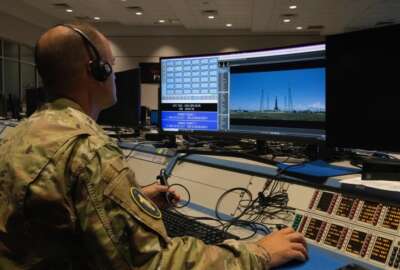The latest national security scorecard
The latest national security scorecard from a data analytics firm shows "a nation immersed in an all-encompassing struggle to preserve its global leadership."
The latest national security scorecard from data analytics firm Govini shows “a nation immersed in an all-encompassing struggle to preserve its global leadership and national security.” We get highlights on the Federal Drive with Tom Temin from Govini CEO Tara Murphy Dougherty.
Interview transcript:
Tom Temin The latest national security scorecard from data analytics firm Govini shows “a nation immersed in an all-encompassing struggle to preserve its global leadership and national security.” We get highlights now from Govini CEO Tara Murphy Dougherty. Tara, good to have you back.
Tara Murphy Dougherty Good to be here, Tom.
Tom Temin And the scorecard is an annual thing. Just review again, what the inputs are and what actually is saying from the macro level.
Tara Murphy Dougherty Absolutely. So, the annual scorecard is an analysis that Govini publishes every year, looking at the data that we collect from a lot of different sources about the companies, the capabilities and the capital that drive U.S. national security. This analysis this year is really focused on critical technology areas where the United States federal government is investing and takes a look at those investments through the lens of a number of different applications, ranging from supply chain to science and technology to some of the core aspects of the defense acquisition process, like production and sustainment and modernization. And, fundamentally, what it’s meant to do is provide a data-driven basis for leaders and decision makers and people who are part of the national security ecosystem to understand where does the United States stand globally? Are we doing enough? Are we investing in the right areas? And how do the numbers compare to what we see coming out of our greatest global competitor, China?
Tom Temin And it sounds like we’re not really keeping up, from looking at some of the numbers.
Tara Murphy Dougherty It’s true. Some of the numbers are quite stark when you look at activity in China in critical technology areas relative to what the United States is doing. And I’ll point to one category, which is just one example of where the numbers are quite different: patents. So, China is pursuing a very purposeful strategy of dominating the patent application space in technology areas that are going to impact national security moving forward and global competitiveness. Now, the count of patents is just one measure, and certainly others need to be taken into account. But it is a reflection of how dominant China is in terms of having very purposeful approaches to advancing technology in areas like advanced materials and manufacturing, for example.
Tom Temin Well, let me ask, sort of pull the thread on that, because there’s an international patent system in which some nations recognize the patents and intellectual property of others. I don’t think China is party to that. And if you are in a struggle for eventually what you’ll need as military dominance, do we really care what they patent? If there’s something that China has patented in China, and maybe in North Korea, or whoever else they cooperate with, why would we say, well, you know, that’s the Chinese patent system, let’s grab that? Because we know they certainly grab everything we produce, illicitly or otherwise, and then go ahead and develop it.
Tara Murphy Dougherty They certainly do. And we see that intellectual property theft behavior continuing. I think what’s concerning about the patent activity as a reflection of the Chinese Communist Party’s focus in certain technology areas, is you look at where they’re very active, and its underlying core foundational technologies, such as 5G, or blockchain or artificial intelligence. And, so, while the United States may be able to compete in any one of those areas with China and globally, the underlying contributions of developments that they make from a technology perspective, will impact how we think about the development of military capabilities moving forward. Now, of course, the United States does participate in a number of international treaties. And when we do, we tend to follow the rules. And, so, in a way, this is all exacerbated by the fact that it’s not a level playing field because of our adherence to certain international commitments that we don’t see our adversaries respecting.
Tom Temin And since World War Two, there has been maybe a couple of eras, you might say, in military and technology modernization. Immediately after the war, it was all about nuclear development, and how to deter missiles coming into the United States. That’s like the Eisenhower Kennedy build up era. And then in the Reagan era, roughly speaking, there was the development of the stealth technologies, precision guidance, and so forth, to give the edge when everybody else had nuclear weapons and ICBMs and counter missile deterrence and so forth. Now, it seems to be hypersonics and artificial intelligence and swarming drones and so forth. But those technologies, unlike the earlier ones, are in some sense already diffused throughout the world, which makes it harder to use those things to military advantage. Fair way to look at it?
Tara Murphy Dougherty Absolutely fair, and artificial intelligence is probably the best exemplar of exactly that dynamic you’re describing. Where we see the United States at the federal government level, investing billions of dollars a year into AI technologies, if we just focus on the main driver of those investments, the Department of Defense, there was $1.8 billion requested in the 2024 federal budget for DoD for AI alone. When you look at what checks they actually wrote, what the contract awards were in that space, it was even greater, it was about $2 billion. Those are good signals that DoD is serious about the application of AI for warfighting capabilities. And, frankly, its business processes, with two major caveats, Tom. One is that the vast majority of DoD AI spending still falls in the category of research and development, instead of putting AI into production systems. And the second point is relative to investments that major commercial entities are making, essentially the American private sector, what it is investing in AI, those DoD numbers pale in comparison. And, so, I think the takeaway here is that the Department of Defense is still thinking about AI as a research project and an early stage area of exploration and needs to advance much farther in the adoption and acceleration of its use for production systems today.
Tom Temin We’re speaking with Tara Murphy Dougherty. She’s CEO of Govini. And if you look at AI in the way you’ve described it, then, it hasn’t even reached the stage of where it has to cross the valley of death, it’s still back in the research stage. There are other technologies, though, that are kind of in the valley of death, as DoD itself calls it. Like hypersonics, we’ve been talking about hypersonics for so long, decades, really. I’ve seen a hypersonic launch pad at one of the naval facilities. And it’s a big, handmade, primitive thing. It looks like it could be built in the 1930s as much as in the 2000s. What about some of those technologies that actually do exist, that can’t seem to quite get born?
Tara Murphy Dougherty Hypersonics is a really interesting example. And there’s a ton of potential for the United States to leverage advancements in this area for American military dominance. You know, what makes hypersonics interesting in the context of the valley of death is, it’s a good example of where there are little to no commercial applications. And, so, this is a case where DoD really has to rely on the defense contracting community, the companies that aren’t trying to be dual use, although I think some of them have applications that are relevant to hypersonics, and focus on driving its own progress. And then the counterpoint to that are, you know, many other areas of autonomy, whether it’s at a vehicle or a platform level, or its fuel and battery development, and all sorts of technology areas that are either a perfect fit for companies that are dual use, or they’re primarily driven by advancements in the commercial sector. Software certainly falls in that category, where the American private sector has dominated software development around the world, and has born some of the best commercial software products and product companies in the entire world. And yet, we still see a lot of software initiatives suffer through the valley of death or autonomy effort suffer through that same process, because fundamentally, the department is still working on navigating that transition out of R&D, and into the procurement and production stage. It is something where I think DIU has made a very positive impact. And there are other signs of progress in this regard, but by no means has the problem been solved.
Tom Temin And finally, there’s other areas where we already have capability and have been using it for some time. And yet that area of technology itself is advancing and maybe we’re not keeping up. I’m thinking in terms of drones, and now everybody’s got drones. And sometimes the cheap, almost homemade types of drones have been very effective we’ve seen in a couple of active military domains in the world. What about the issue of keeping given technology up to date?
Tara Murphy Dougherty Certainly Ukraine has shown exactly that point. You don’t need the multibillion dollar program of record to put a very effective drone into the air and use it for military purposes. And indeed, to your point, Tom, we see a lot of momentum in the Department of Defense today around counter UAS and investing in capabilities to now combat the threat of these unmanned aerial systems. So it’s a tough challenge because it means we both have to be at the bleeding edge of the offensive capabilities as well as realizing that when it comes to areas like autonomy, and it comes to capabilities like drones, they’re very accessible to a wide range of actors. And so our defenses have to be stellar as well.
Tom Temin So, to summarize, would you say the scorecard this year is kind of a wake up call and a warning?
Tara Murphy Dougherty The scorecard is a wake up call. That’s a great way of putting it, and the most powerful aspect of that is that it is data driven. And, so, I believe that policy conversations are always better when they have quantitative analysis and data points to back them up. The Department of Defense loves to run on Anik data. But that has been a changing trend for a number of years, and this year, the scorecard can contribute in a meaningful way to progress continuing in the right direction in that regard.
Tom Temin Tara Murphy Dougherty is CEO of Govini. Thanks so much for joining me.
Tara Murphy Dougherty Thanks for having me, Tom.
Tom Temin We’ll post this interview along with a link to the scorecard at federalnewsnetwork.com/federaldrive. Subscribe to the Federal Drive wherever you get your podcasts.
Copyright © 2024 Federal News Network. All rights reserved. This website is not intended for users located within the European Economic Area.
Tom Temin is host of the Federal Drive and has been providing insight on federal technology and management issues for more than 30 years.
Follow @tteminWFED







